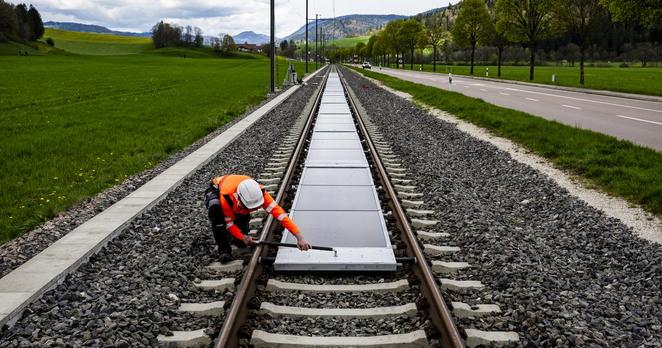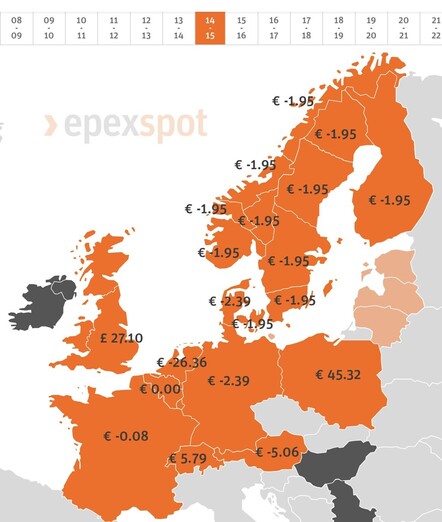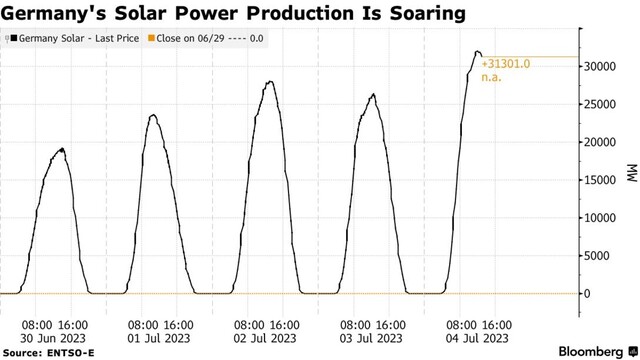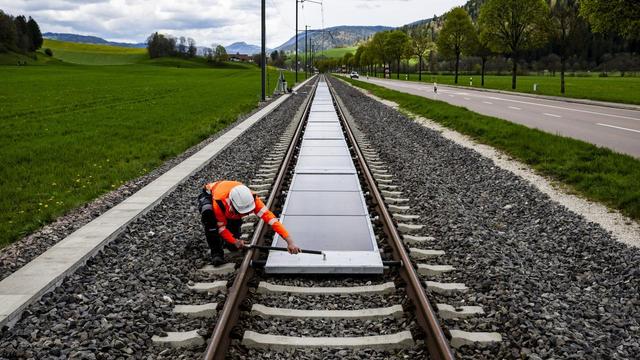https://twitter.com/gerardreid14/status/1662356280042766336
https://twitter.com/gerardreid14/status/1662356280042766336
☀️⚡️ Everyone in Switzerland agrees we need more solar. But often, there's disagreement about where to put the panels without impacting the landscapes too much.
🛤️ Looking back, this one is a no-brainer, why not lay them down between train rails: there's already a strong connection to the grid, and it's infrastructure that's already ‘built’.
🇨🇭 First segment of the tracks got inaugurated today in canton Neuchâtel.
https://www.rts.ch/info/regions/neuchatel/2025/article/la-premiere-centrale-solaire-sur-rails-a-ete-inauguree-dans-le-canton-de-neuchatel-28863275.html
Supplier: https://www.sun-ways.ch

La première centrale solaire sur rails a été inaugurée dans le canton de Neuchâtel
C'est un projet inédit en Suisse: la première centrale solaire amovible sur une voie ferrée ouverte au trafic ferroviaire a été inaugurée jeudi à Buttes, dans le canton de Neuchâtel. Des trains voyageurs vont donc circuler par-dessus une installation photovoltaïque.
@fj it's cute but even if you did all of it, 3800 km of standard gauge at 1.4mish wide with an energy density of roughly 100 W/m² gives you about 500 MW of power total, i.e. 10% of current (tiny) Swiss solar capacity.
You could get the same capacity by converting 0.03%(!) of Swiss agricultural land to solar.
@ives I'm not really convinced by roof solar, it's cute and fun, but installing solar on farmland is much cheaper and you can get an added ecological benefit by rewilding the land quite significantly, seeding meadows beneath and around the panels
https://solarenergyuk.org/news/wildlife-found-thriving-on-solar-farms/ (it's from an industry group, so take with a pinch of salt, but look at how gorgeous those meadows are...)
@bovine3dom Built infrastructure is already claimed land.
30% of urban space is streets or car parks. Either of those can be claimed relatively easily.
Large construction, especially warehouses, are very easy to deck with solar, and contribute usefully to reducing summer cooling loads. Probably winter as well.
Plants "eat" sunlight, and solar vs. agriculture is inherently rivalrous. Much of Europe is constrained for food production already, and farmland, particularly in the Netherlands is some of the most productive in the world, both in kg/hectare and €/hectare bases.
13% of the Netherlands is built-up area, either buildings or roads. Assuming full utilisation (a stretch) that's on the order of 500 GWe capacity. Roughly 250 large nuclear power stations.
In practice, likely much less of that could be effectively developed, but even 10% would be a substantial generating capacity.
And with no claims on farm, forest, or natural areas.
Another option would be floating solar, which has been proposed elsewhere. Near-offshore, sheltered from waves/storms, could also be substantial.
@dredmorbius i think the crux of my disagreement is that you're assuming that farm land is land used efficiently. In the Netherlands for vegetables it is, but in many other countries it is used extremely inefficiently and animal farming inherently uses loads of space for very little food
not to mention the huge benefits to nature of rewilding these ecological deserts while you add solar, which you don't get from urban solar
@bovine3dom Well, to the credit of my argument, we are in fact discussing the Netherelands.
Or Switzerland, also not particularly abundant in farmland.
There are crops which benefit from shading. However, again, plants literally eat sunlight, and if you're taking from insolation you will, all else being equal, be reducing the agricultural potential.
(All is not of course always equal, but that would also suggest that the crop being grown isn't ideally suited to the land in question.)
If you're looking at solar siting, again, built environment gives ready wins, as does placement on/near linear infrastructure (rail lines, aqueducts, highways). Or in non-arable land, particularly deserts, of which there are few in Europe proper, but large extants within the proximate region.
Again, Europe is agriculturally constrained, and will continue to be barring either sharp reductions in population or frankly unlikely improvements in per-hectare output in a crude caloric and nutritional basis.
Rooftop space doesn't suffer from these constraints, is reasonably abundant, and is proximate to other essential infrastructure (electrical transmission, substations, end-use, etc., etc.).
@dredmorbius we were talking about Switzerland and Belgium, unless you have some very controversial opinions about Flanders :)
the idea that Europe is agriculturally constrained is new to me. do you have any data on that? my understanding is that there is a huge productivity gap with the Netherlands and US due to politics rather than geography.
My humble opinion is that Switzerland should have approximately zero farms and import everything from the Po valley but I understand some disagree
@bovine3dom Europe being ag-constrained is pretty well-known. It's driven by a number of factors, including population density, extant land-use, economic factors (high labour costs tend to push out low-profit but diet-critical crops such as bulk grains (wheat, maize, rice, barley, oats) in favour of high-profit luxury crops (flowers, table crops, wine grapes, etc.).
From your subsequent toot, the fact that the Netherlands has little viable crop-yield potential actually restates this: farm yields are already near or at their optimum values given current technology and practices. I'll take as given that Eastern European yields could be increased, but that's also fairly predictable given weaker economies and purchasing power (hence: less-capable mechnisation and reduced / non-optimal fertiliser and pesticide use). A non-EU example would be Sri Lanka whose economic collapse has lead to a curtailment of ag-input imports (fertilisers, pesticides, mechanisation goods and maintenance), and a corresponding productivity collapse in a country that's already food-perilous.
Look to EU farm imports debates for the significance of this debate. Key source countries for imports include the US, Brazil, Agentina (both are major beef exporters), Ukraine, and India.
For per-nation breakouts see: https://wits.worldbank.org/CountryProfile/en/Country/EUN/Year/2021/TradeFlow/Import/Partner/by-country/Product/16-24_FoodProd
General policy:
The European Union is a major importer of food and feed...
https://food.ec.europa.eu/horizontal-topics/official-controls-and-enforcement/imported-products_en
(This focuses more on quality than quantity, but establishes significance.)
UK (noting not EU proper, but similar characteristics):
The UK continues to source food from domestic production and trade at around an overall 60:40 ratio.... The production-to-supply ratio was at 62% for all food and 75% for indigenous foods (meaning those that can be grown in the UK) in 2023, showing a small increase from 61% and 74% in 2021.
European Union Food Products Imports by country 2021 | WITS Data
Merchandise trade and tariff data for European Union (EUN) Food Products import from all countries (trading partner) including Trade Value, Product Share, MFN and Effectively applied tariffs, count of duty free and dutiable products for 2021
@dredmorbius i agree that NL is near max food production (unless it moved some animal to vegetable production). i am also well aware that the UK has not been self sufficient in food for around three hundred years. which does mean i think it would be daft to try to be self sufficient now.
electricity is hard to transport over long distances, food is easy to transport. so let's do the easy stuff?
i also don't think that the fact that we have imports precludes increasing productivity.
@bovine3dom Electricity is remarkably easy to transmit long distances. HVAC and HVDC transmission losses are ~6% or so. Most of the T&D losses (transmission and distribution) are actually the Carnot losses of thermal -> generator losses (about 40--60%). There is some transformer / inverter loss, but transmission is on balance pretty cheap. Since long-distance transmission follows few paths and fairly straight lines, there's also remarkably little required infrastructure relative to benefit.
https://www.eia.gov/tools/faqs/faq.php?id=105&t=3
The challenge for, say, a NorAfrican solar plant servicing Europe would be trans-Mediterranean links. Those remain viable, however, with either a Gibraltar or MidEast route being most likely. (Political and military stability of the latter are the greatest concern, not technical viability.) If solar -> synfuel is opted for (far less efficient, but far more storable), transport and distribution is virtually identical to current petroleum-based hydrocarbons, and could rely on extant plant (ships, pipelines, terminals, storage & distribution).
Several IPCC reports specifically explore decarbonisation pathways. Vaclav Smil's books on energy transition are also strongly recommended.
Regards food: imports work fine so long as global trade and political systems support it. That picture is darkening markedly, and relying on very long supply chains presents risks and challenges. The extent to which local capacity can be sustained, it's likely beneficial to do so. The same argument applies to energy imports, but solar imports (electricity, synfuel) are fairly fungible, and EU comparative advantage is in food production rather than energy.
That's arguable, of course, but in general I suspect the balance of advantage is to grow food comparable to current levels, and import renewables. Remember too that built-environment solar remains a viable option, and one that doesn't compete with food as I hope I've detailed sufficiently.
@dredmorbius i think we are broadly in agreement. i think the EU could do fine with a few percent fewer farms and that switching them to solar would be quicker than trying to build HVDC under the sea.
we should do that too and stick a rail tunnel there while we're at it
going all the way back to what started this argument i essentially want us to make it legal for farmers to switch to solar if they want. and for us not to put stupid taxes on solar panels because the wrong foreigner made them




